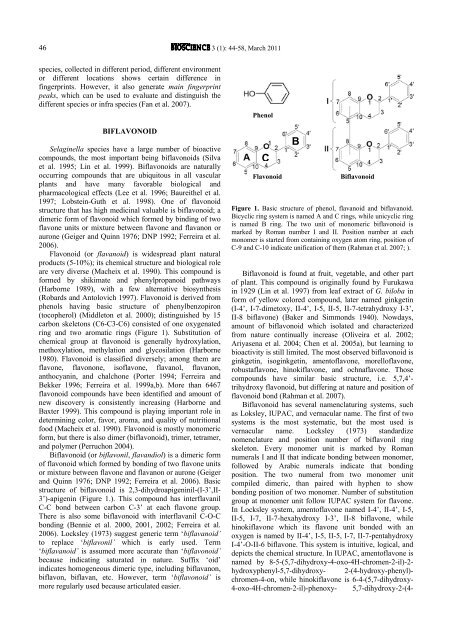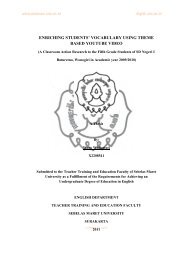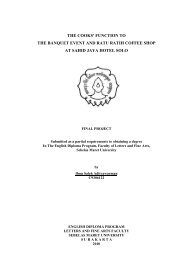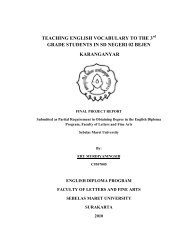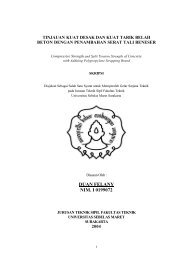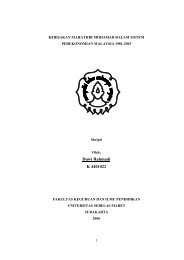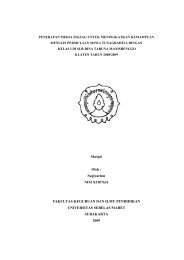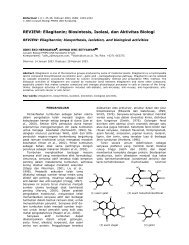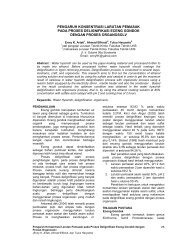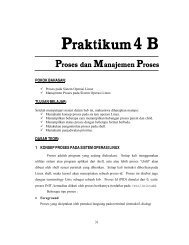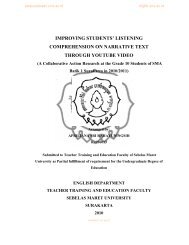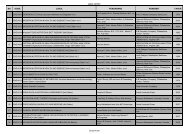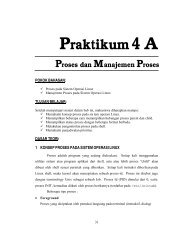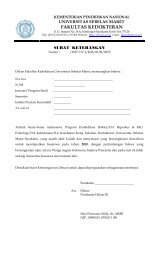ISSN 2087-3940 (PRINT) | ISSN 2087-3956 ... - Biodiversitas
ISSN 2087-3940 (PRINT) | ISSN 2087-3956 ... - Biodiversitas
ISSN 2087-3940 (PRINT) | ISSN 2087-3956 ... - Biodiversitas
Create successful ePaper yourself
Turn your PDF publications into a flip-book with our unique Google optimized e-Paper software.
46<br />
3 (1): 44-58, March 2011<br />
species, collected in different period, different environment<br />
or different locations shows certain difference in<br />
fingerprints. However, it also generate main fingerprint<br />
peaks, which can be used to evaluate and distinguish the<br />
different species or infra species (Fan et al. 2007).<br />
BIFLAVONOID<br />
Selaginella species have a large number of bioactive<br />
compounds, the most important being biflavonoids (Silva<br />
et al. 1995; Lin et al. 1999). Biflavonoids are naturally<br />
occurring compounds that are ubiquitous in all vascular<br />
plants and have many favorable biological and<br />
pharmacological effects (Lee et al. 1996; Baureithel et al.<br />
1997; Lobstein-Guth et al. 1998). One of flavonoid<br />
structure that has high medicinal valuable is biflavonoid; a<br />
dimeric form of flavonoid which formed by binding of two<br />
flavone units or mixture between flavone and flavanon or<br />
aurone (Geiger and Quinn 1976; DNP 1992; Ferreira et al.<br />
2006).<br />
Flavonoid (or flavanoid) is widespread plant natural<br />
products (5-10%); its chemical structure and biological role<br />
are very diverse (Macheix et al. 1990). This compound is<br />
formed by shikimate and phenylpropanoid pathways<br />
(Harborne 1989), with a few alternative biosynthesis<br />
(Robards and Antolovich 1997). Flavonoid is derived from<br />
phenols having basic structure of phenylbenzopiron<br />
(tocopherol) (Middleton et al. 2000); distinguished by 15<br />
carbon skeletons (C6-C3-C6) consisted of one oxygenated<br />
ring and two aromatic rings (Figure 1). Substitution of<br />
chemical group at flavonoid is generally hydroxylation,<br />
methoxylation, methylation and glycosilation (Harborne<br />
1980). Flavonoid is classified diversely; among them are<br />
flavone, flavonone, isoflavone, flavanol, flavanon,<br />
anthocyanin, and chalchone (Porter 1994; Ferreira and<br />
Bekker 1996; Ferreira et al. 1999a,b). More than 6467<br />
flavonoid compounds have been identified and amount of<br />
new discovery is consistently increasing (Harborne and<br />
Baxter 1999). This compound is playing important role in<br />
determining color, favor, aroma, and quality of nutritional<br />
food (Macheix et al. 1990). Flavonoid is mostly monomeric<br />
form, but there is also dimer (biflavonoid), trimer, tetramer,<br />
and polymer (Perruchon 2004).<br />
Biflavonoid (or biflavonil, flavandiol) is a dimeric form<br />
of flavonoid which formed by bonding of two flavone units<br />
or mixture between flavone and flavanon or aurone (Geiger<br />
and Quinn 1976; DNP 1992; Ferreira et al. 2006). Basic<br />
structure of biflavonoid is 2,3-dihydroapigeninil-(I-3’,II-<br />
3’)-apigenin (Figure 1.). This compound has interflavanil<br />
C-C bond between carbon C-3’ at each flavone group.<br />
There is also some biflavonoid with interflavanil C-O-C<br />
bonding (Bennie et al. 2000, 2001, 2002; Ferreira et al.<br />
2006). Locksley (1973) suggest generic term ‘biflavanoid’<br />
to replace ‘biflavonil’ which is early used. Term<br />
‘biflavanoid’ is assumed more accurate than ‘biflavonoid’<br />
because indicating saturated in nature. Suffix ‘oid’<br />
indicates homogeneous dimeric type, including biflavanon,<br />
biflavon, biflavan, etc. However, term ‘biflavonoid’ is<br />
more regularly used because articulated easier.<br />
Phenol<br />
C<br />
Flavonoid<br />
B<br />
Biflavonoid<br />
Figure 1. Basic structure of phenol, flavanoid and biflavanoid.<br />
Bicyclic ring system is named A and C rings, while unicyclic ring<br />
is named B ring. The two unit of monomeric biflavonoid is<br />
marked by Roman number I and II. Position number at each<br />
monomer is started from containing oxygen atom ring, position of<br />
C-9 and C-10 indicate unification of them (Rahman et al. 2007; ).<br />
Biflavonoid is found at fruit, vegetable, and other part<br />
of plant. This compound is originally found by Furukawa<br />
in 1929 (Lin et al. 1997) from leaf extract of G. biloba in<br />
form of yellow colored compound, later named ginkgetin<br />
(I-4’, I-7-dimetoxy, II-4’, I-5, II-5, II-7-tetrahydroxy I-3’,<br />
II-8 biflavone) (Baker and Simmonds 1940). Nowdays,<br />
amount of biflavonoid which isolated and characterized<br />
from nature continually increase (Oliveira et al. 2002;<br />
Ariyasena et al. 2004; Chen et al. 2005a), but learning to<br />
bioactivity is still limited. The most observed biflavonoid is<br />
ginkgetin, isoginkgetin, amentoflavone, morelloflavone,<br />
robustaflavone, hinokiflavone, and ochnaflavone. Those<br />
compounds have similar basic structure, i.e. 5,7,4’-<br />
trihydroxy flavonoid, but differing at nature and position of<br />
flavonoid bond (Rahman et al. 2007).<br />
Biflavonoid has several namenclaturing systems, such<br />
as Loksley, IUPAC, and vernacular name. The first of two<br />
systems is the most systematic, but the most used is<br />
vernacular name. Locksley (1973) standardize<br />
nomenclature and position number of biflavonil ring<br />
skeleton. Every monomer unit is marked by Roman<br />
numerals I and II that indicate bonding between monomer,<br />
followed by Arabic numerals indicate that bonding<br />
position. The two numeral from two monomer unit<br />
compiled dimeric, than paired with hyphen to show<br />
bonding position of two monomer. Number of substitution<br />
group at monomer unit follow IUPAC system for flavone.<br />
In Locksley system, amentoflavone named I-4’, II-4’, I-5,<br />
II-5, I-7, II-7-hexahydroxy I-3’, II-8 biflavone, while<br />
hinokiflavone which its flavone unit bonded with an<br />
oxygen is named by II-4’, I-5, II-5, I-7, II-7-pentahydroxy<br />
I-4’-O-II-6 biflavone. This system is intuitive, logical, and<br />
depicts the chemical structure. In IUPAC, amentoflavone is<br />
named by 8-5-(5,7-dihydroxy-4-oxo-4H-chromen-2-il)-2-<br />
hydroxyphenyl-5,7-dihydroxy- 2-(4-hydroxy-phenyl)-<br />
chromen-4-on, while hinokiflavone is 6-4-(5,7-dihydroxy-<br />
4-oxo-4H-chromen-2-il)-phenoxy- 5,7-dihydroxy-2-(4-


